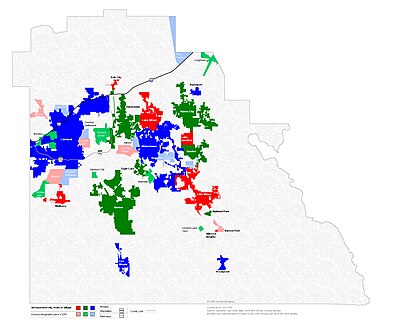Polk County, Florida
The first people to inhabit the area now called Polk County were the Paleoindians who arrived in Florida at least 12,000 years ago, late in the last ice age.With large amounts of water locked up in continental ice caps, the sea level was more than 150 feet (46 m) lower than at present.The largest collection of late (more than 9,500 years ago) Paleoindian microlithic tools known from Florida were found in Lake Weohyakapka, near Nalcrest in Polk County.In eastern Polk County, the Kissimmee River valley was occupied by people of the Belle Glade culture, which persisted from about 3,000 years ago until the collapse of the Native American population in Florida after 1700.An attempt to remove all Native Americans in Florida to west of the Mississippi River, starting in 1832, led to the Second Seminole War.By 1837, the Seminoles were being pushed south, and late that year, Colonel Zachary Taylor, as part of a coordinated push against the Seminoles, led a column east from Fort Brooke (today's Tampa) into what is now Polk County, and then south between the Kissimmee and Peace River valleys, culminating in the Battle of Lake Okeechobee.It was formed from the eastern part of Hillsborough County and named in honor of former US President James K. Polk,[13] who had been popular with Southerners for supporting the expansion of slavery[14] and whose 1845 inauguration was on the day after Florida became a state.Colonel Bartow was buried in Savannah, Georgia, with military honors, and promoted posthumously to the rank of brigadier general.As the third courthouse to stand on the site, the present structure houses the Polk County Historical Museum and Genealogical Library.[citation needed] In the post-Reconstruction period, black railway workers were among the first African Americans to settle in Polk County, in 1883 south of Lake Wire.The county seat became the hub of the largest phosphate industry in the United States, attracting both immigrants and African-American and white workers from rural areas.In 1967, a white man shot and severely wounded a popular African-American high-school football player who was integrating Lake Ariana Beach.[17] Fred Rochelle, 16, was burned alive in a public spectacle lynching before thousands in Polk County, Florida, in 1901.[21] Since the late 20th century, growth in Polk County has been driven by its proximity to both the Tampa and Orlando metropolitan areas along the Interstate 4 corridor.Recent growth has been heaviest in Lakeland (closest to Tampa) and the northeast areas near Haines City (nearest to Orlando).Owners were bought out in 1967 by eminent domain for county civic development of a conference center and the later Veterans Memorial Park.Polk County is within the Central Florida Highlands area of the Atlantic coastal plain, with a terrain consisting of flatland interspersed with gently rolling hills.Part of the Lake Wales Ridge runs through eastern Polk County, which is known for its rolling hills with unique wildlife and plants.[27] During the summer rainy season from June to September, sea breezes from both coasts move inland, where the moist air is heated and rises to form thunderstorms.In the predawn hours of January 8, 2008, smoke from a prescribed burn contributed to especially dense fog on Interstate 4 that caused a major pileup involving 70 vehicles in 10 separate crashes that resulted in five deaths.U.S. Census Bureau 2010 Ethnic/Race Demographics:[45][46] In 2010, the largest ancestry groups were: 12.2% German, 11.6% American, 11.2% English, 10.8% Irish, 7.6% Mexican, 5.8% Puerto Rican, 4.1% Italian, 2.6% French, 2.1% Polish, 2.0% Scotch-Irish, 1.8% Scottish, 1.5% Dutch, and 1.2% Cuban.[19] Notable companies headquartered in Polk County include Publix (an employee-owned grocery chain) and Florida's Natural (an agricultural cooperative).The top employers of Polk County are as follows:[53] Polk County is home to professional baseball and basketball teams and boasts a rich history of collegiate sports competition at a number of its institutions of higher learning, including perennial NCAA Division II national championship contender and titleholder (in multiple sports), Florida Southern College.[54][55] Professional basketball made its debut in 2017 when the Lakeland Magic took the court in its home venue, RP Funding Center.While the county is divided into five separate districts, each commissioner is elected at-large, countywide,[58] requiring them to gain majority support.[52] The commission is responsible for providing appropriations for other countywide offices including the sheriff, property appraiser, tax collector, and supervisor of elections.A portion of the county's budget is dedicated to providing municipal-level services and regulations to unincorporated areas, such as zoning, business codes, and fire protection.[62] The cooperative enables the city-owned and -operated public libraries to open their doors to all residents of the county, including those in the unincorporated areas.The selection of materials related to the history of Polk County contains local newspapers dated back to 1881, aerial photography to 1938, city directories to 1925 and property tax rolls to 1882.





CountyFloridaNamed forJames K. PolkBartowLakelandTime zoneUTC−5EasternUTC−4Area codecentralU.S. state2020 censuscounty seat77th-most populous89th-most populousprimary statistical areaLake Waleslast ice agesinkholesmicrolithicLake WeohyakapkaNalcrestKissimmee RiverBelle Glade cultureManasota cultureSafety Harbor culturePeace RiverPonce De LeonTampa BayUrriparacoxiLake CountyOrange CountyOklawaha RiverAcueraAdams-Onis TreatyTreaty of Moultrie CreekSecond Seminole WarZachary TaylorFort BrookeBattle of Lake OkeechobeeHillsborough CountyFrancis S. BartowSavannah, Georgiafreedmenwhite supremacydisenfranchised most blacksJim CrowlynchedColumbia CountyphosphateWorld War IIArmy Air CorpsKu Klux KlanFred RochelleOrlandoHaines Citysuburban sprawl2004 Atlantic hurricane seasonCharleyFrancesJeanneWinter HavenCypress GardensLegoland FloridaPublix supermarketU.S. Census BureauOsceola CountyOkeechobee CountyHighlands CountyHardee CountyManatee CountySumter CountyPasco CountyquadripointFour Corners, Floridahumid subtropical climateKöppenrainy seasonsea breezesprecipitationsunshine hoursHurricane IrmaHurricane JeanneHurricane CharleyHurricane DonnaHurricane King1949 Florida hurricane1945 Homestead hurricane1933 Treasure Coast hurricane1928 Okeechobee hurricaneNational Hurricane CenterHurricane FrancesHurricane Erin (1995)1910 Cuba hurricaneWauchulaGilbert AirportBlack or African AmericanNative AmericanAlaska NativePacific IslanderMixed/multiracialHispanic or Latino2020 United States censusWhite HispanicsBlack HispanicsTwo or more racesOther racesper capita incomepoverty lineforeign-bornnaturalized American citizenscensusNon-Hispanic Whitefirst languageFrench CreoleHaitian Creolemother languageprimary languageminingagriculturetourismPublixFlorida's NaturalPolk County Public Schools